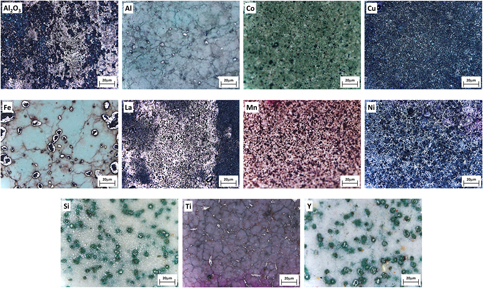Crossref Citations
This article has been cited by the following publications. This list is generated based on data provided by
Crossref.
Zygmuntowicz, J.
Bulski, B.
Szymańska, J.
Piotrkiewicz, P.
and
Kaszuwara, W.
2021.
Characterization of the alumina oxide, copper and nickel powders and their processing intended for fabrication of the novel hybrid composite: A comparative study.
Materialwissenschaft und Werkstofftechnik,
Vol. 52,
Issue. 4,
p.
379.
Samira Shaabani
Jabbari, Morteza
and
Bozorg, Mansoor
2022.
Physicochemical and Mechanical Studies of Al2O3–Cu Metal-Ceramic Composites Obtained by Spark Plasma Sintering.
Russian Journal of Inorganic Chemistry,
Vol. 67,
Issue. 14,
p.
2264.
Piotrkiewicz, Paulina
Zygmuntowicz, Justyna
Wachowski, Marcin
Cymerman, Konrad
Kaszuwara, Waldemar
and
Więcław Midor, Anna
2022.
Al2O3-Cu-Ni Composites Manufactured via Uniaxial Pressing: Microstructure, Magnetic, and Mechanical Properties.
Materials,
Vol. 15,
Issue. 5,
p.
1848.
Ben Romdhane, Anas
Veys-Renaux, Delphine
NDiaye, Mouhamadou Moustapha
Bruyère, Stéphanie
Elleuch, Khaled
and
Rocca, Emmanuel
2022.
Anodizing of AS12 alloy in alkaline media.
Applied Surface Science,
Vol. 572,
Issue. ,
p.
151436.
Szutkowska, Magdalena
Cyboroń, Jolanta
Podsiadło, Marcin
and
Polczyk, Tomasz
2022.
Residual stresses in alumina matrix composites reinforced with Ti(C,N).
Ceramics International,
Vol. 48,
Issue. 12,
p.
17116.
Piotrkiewicz, Paulina
Zygmuntowicz, Justyna
Wachowski, Marcin
Szachogłuchowicz, Ireneusz
and
Kaszuwara, Waldemar
2024.
Influence of the second metal component on processing and selected properties of Al2O3-Cu hybrid composites.
Processing and Application of Ceramics,
Vol. 18,
Issue. 1,
p.
98.
Al-Qutub, Amro
AlHamed, Ahmed Abdullah Saad
and
Samad, Mohammed Abdul
2024.
Tribological characterisation of 6061 aluminium alloy reinforced with submicron alumina particle under solid lubrication at room temperature.
Tribology - Materials, Surfaces & Interfaces,
Vol. 18,
Issue. 2,
p.
115.
Zhu, Yunlong
Xu, Xiang
Zhang, Jie
Meng, Xiang
Gao, Rui
Wang, Cong
Chen, Shuying
Peng, Qiqing
Wang, Haidou
and
Liu, Ming
2024.
Research on the ablation resistance of Al2O3/PF composite coatings deposited by supersonic plasma spraying on resin matrix surfaces.
Surface and Coatings Technology,
Vol. 491,
Issue. ,
p.
131140.
Singh, Priyanka
Chauhan, Nathi Ram
and
S, Rajesha
2024.
Effect of the addition of ductile phase on mechanical properties of Alumina/nano SiC ceramic composite.
Advances in Materials and Processing Technologies,
Vol. 10,
Issue. 4,
p.
2709.
Al-Qutub, Amro
Al-Hamed, Ahmed Abdullah Saad
and
Mohammed, Abdul Samad
2024.
Elevated Temperature Tribological Performance of Submicron Alumina Particle-Reinforced 6061 Aluminum Alloy Under Dry Conditions.
Arabian Journal for Science and Engineering,
Vol. 49,
Issue. 2,
p.
1597.
Yang, Zhiyuan
Yang, Li
Tang, Shiyan
Xu, Zizhen
Liu, Jingfei
Zhao, Jianwei
and
Fan, Zitian
2025.
In-situ sintered mullite whiskers to enhance the thermal shock resistance of binder jetting Al2O3-based ceramics.
Materials Characterization,
Vol. 224,
Issue. ,
p.
114986.
Yan, Junwei
Li, Enzhu
Zhong, Chaowei
Qin, Tianying
and
Wang, Mingxia
2025.
Preparation and properties of zirconia-toughened alumina doped with B2O3-Al2O3-SiO2-ZrO2 glass.
Ceramics International,
Vol. 51,
Issue. 20,
p.
30348.


